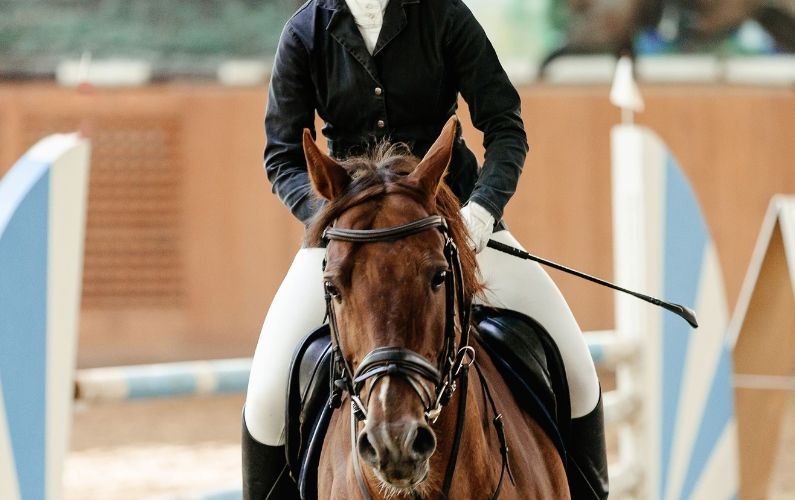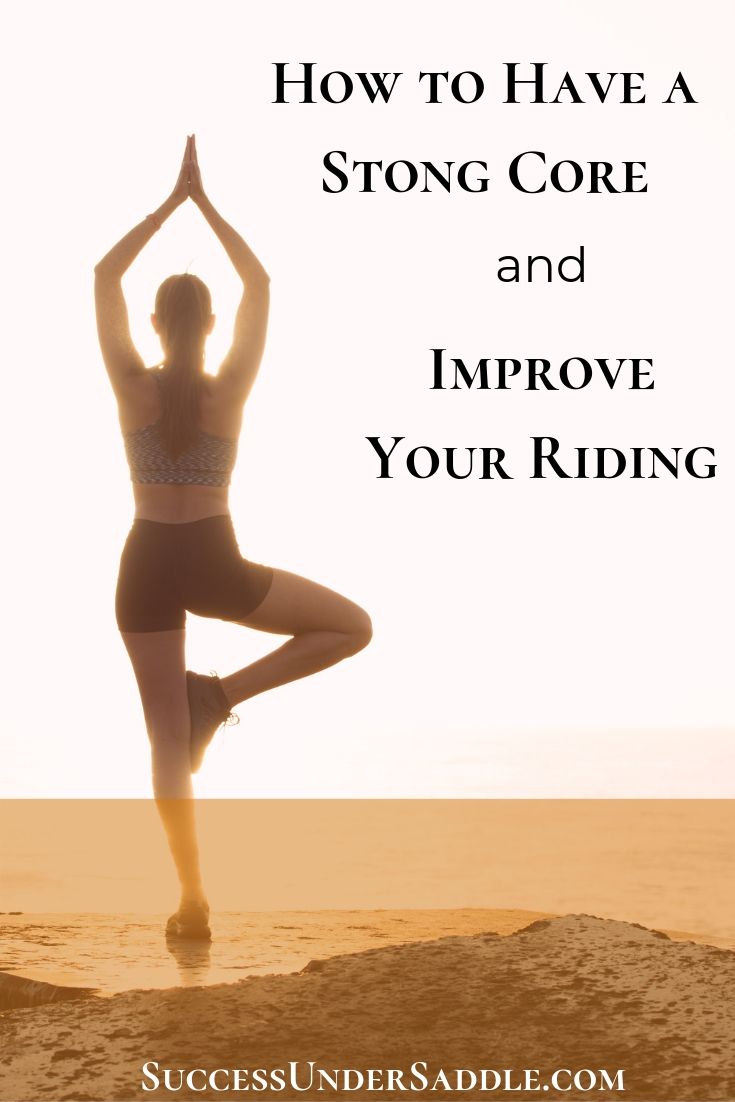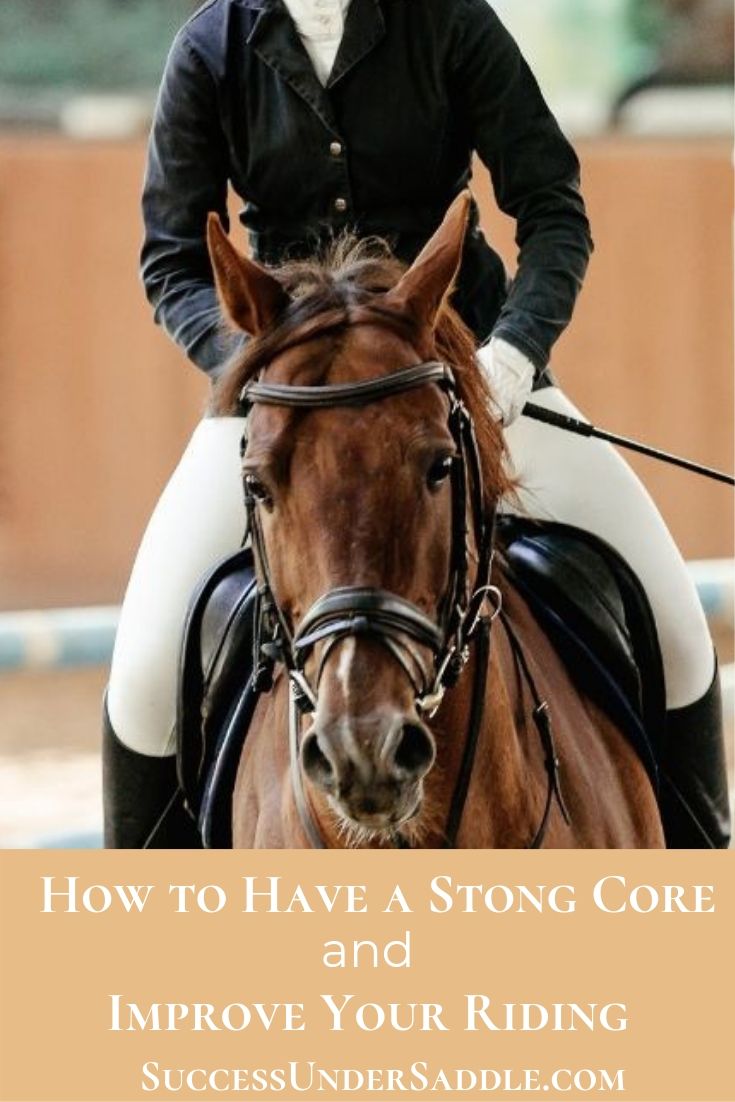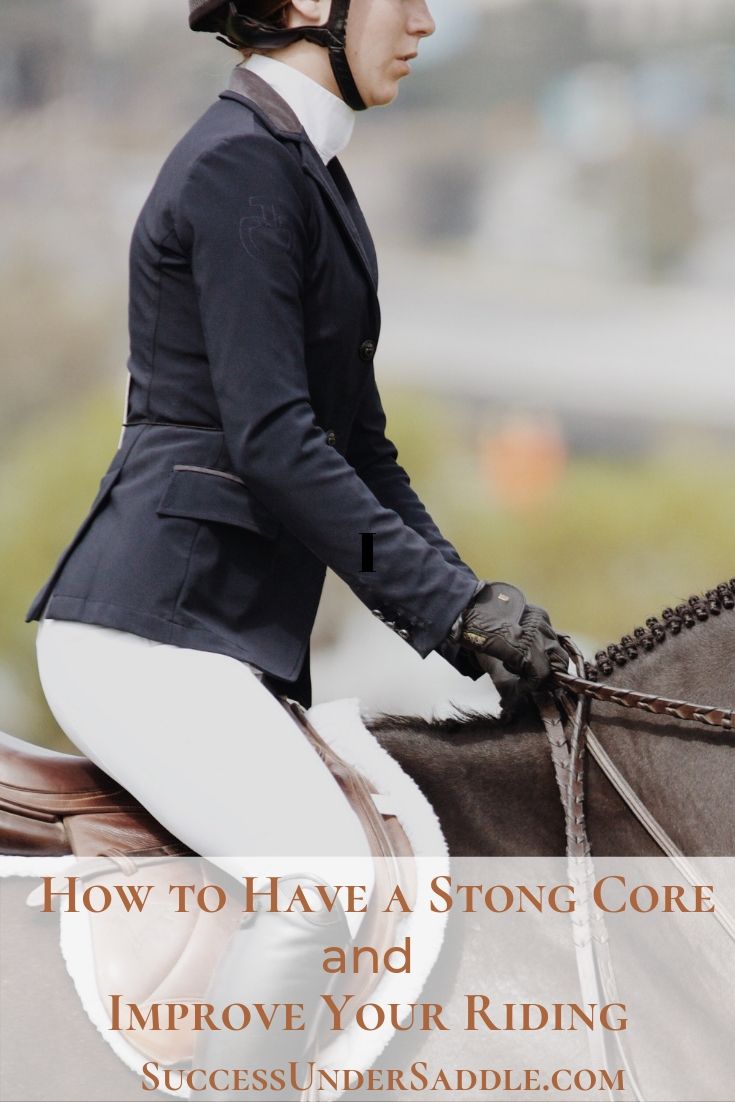This post may contain affiliate links. Please read our disclosure for more info.
What is the “Core”?
How can strengthening your core improve your riding? In this age of fitness, you undoubtedly have heard the term “strengthening your core”. So what exactly is our “core” and why is it important to our riding? I have always thought of the core as basically, our abs. But our core is much more than that.
If we were to chop off our legs, arms and head, what is left is our core. It’s sometimes referred to as our torso. It’s the section from our shoulders to our hips, all the way around and deep within our bodies. This includes not only our outer abdominal muscles, our deepest abdominal muscles, our entire back muscles, our pelvic muscles, and the muscles at the side and back of our hips. It is also all the internal stabilizer muscles that support our spine, the muscles that help keep our pelvis balanced, and the muscles supporting our shoulders. That’s a lot of muscles!
There are 24 joints in the spine that sit on top of the horse and experience waves of motion from their base. Core muscles wrap around the torso in layers, and go in different directions to support the stability of our torso and movement. Our bodies work as an entire unit. You can think of the core as the foundation. Everything is connected. These muscles provide stability to our torso and link our upper and lower body enabling us to move in any direction or stand in one spot without losing balance.
If you want a stronger core, you must focus on all of them.
Why is core strength important in horse riding?
Most sources agree that core strength is important for riders of all disciplines. In fact, whether you practice any sport or not, core strength is a significant key to life in general. A weak core can undermine the motions that are part of everyday life, such as walking, bending, turning, dressing, and bathing. Let alone the larger movements of sports activities including riding.
If we as riders aren’t fit, toned and strong in the back and abdominal muscles, our seat will not be strong enough to engage the horse or follow its movement sufficiently and correctly. A strong core is important because riders ride mostly with the torso and seat. Whether you realize it or not, our limbs are completely secondary aids to our seat, weight and torso orientation.
Core muscles control our hip mobility and stability sitting on our horse, our posture, and the independence of our shoulders and hips. They are responsible for control over our seat and leg placement and protecting our spine so that it is free to absorb our horse’s motion.
What are the benefits of a strong core to riders?
- Better Performance – Having a strong core will make you a better rider. It will allow your horse to move freely underneath you. Riders that are unstable on the horse’s back, grip with their knees and use their hands to balance. The result is a tight, tense and short striding horse. One study found that horses whose riders embarked upon an 8 week core strength program, demonstrated increased stride length by the end of the program. Riders with core strength create the illusion that they are totally still on the horse. In fact, they are moving at one with the horse, creating harmony.
- Better Co-ordination– Your core muscles are the bridge connecting your upper and lower body and provide an “anchor” for your shoulders and your legs. Unless you are balanced and strong in your core, it will be nearly impossible to move your hands and legs independently of your seat. Many riders with pulling hands often have weak core muscles. The pulling hands are the body’s compensation for its inability to stabilize the position through the core.
- Reduced risk of injury – Your core is your center of gravity and a strong core will help you stay ‘with the horse’. A strong core renders you more secure in the saddle so that if your horse spooks you will be far less likely to fall off and injure yourself. Strong muscles around the core will help protect your neck, back and hips in the event of a fall.
- Reduced pain– Having a strong core can help reduce lower back pain because all of the muscles surrounding your spine are stable. Instability in the core area means that you can’t absorb the movement of the horse effectively and over time, this will lead to injury because the ligaments and tissue surrounding the spine will be stressed and overworked. Not all back problems, however, are related to a strong core and should be evaluated by a physician. Building your core muscles is only one part of having a pain-free back. Things like good posture, efficient movement, good cardiovascular fitness, and flexibility all factor in to having a healthy back.
How do you know if your Core is weak?
- Posture – To quote one riding instructor, “So many riders have difficulty with their posture in the saddle because they have poor posture out of the saddle”. Poor posture is often an indication of a weak core. If you’re 40 years old and your mother is still telling you to sit up straight, this may be a sign that your core is weak. Your stomach and low back muscles work together to hold your spine upright. If they are weak, your body will be unstable as your muscles fatigue quickly. The result . . . you habitually slouch after a short period of sitting or standing.
- Back Pain – If you experience frequent tightness and pain in your lower back, a weak core could be a part of the problem. If the muscles surrounding the spine are weak, the vertebra and disks won’t be properly supported. In addition, when abdominal muscles are weak, the back muscles have to work overtime to hold you up commonly resulting in muscle spasms.Core weakness may also explain knee, hip, and shoulder issues because those areas of the body end up being overexerted to compensate for the lack of stability, body balance, and control needed to move effectively and properly.
- Digestive Issues – One perhaps surprising sign of a weak core is digestion issues. A weak core and digestion can be related if you have a slouched posture, especially after a meal. When you have poor posture, it may to lead to heartburn caused by acid re-flux. It can also lead to constipation.
- Leaks During Exercise – The pelvic floor muscles are part of your core. They stabilize the pelvis and prevent bladder leaks. When you exercise, run, jump, lift weights, etc. even the smallest amount of bladder leakage could be a sign of a weak core.
- Overall Weakness – If you have problems lifting heavy amounts or jumping, your core may likely be at fault. Weakness in your arms and legs can indicate a poorly conditioned core. Those midsection muscles fuel the strength of your limbs. Pain that comes from strenuous activity can often be traced back to the core.
- Fatigue –A week core will fatigue making you feel like you need a rest. Ever feel exhausted after just a few minutes of waiting in the checkout line? Ever find yourself leaning on something to hold yourself up? Stress in your hips, shoulders, neck, as well as general fatigue from standing, can all be signs of a weak core.
Try this simple test
Sit down in your favorite chair, and get comfortable. Now stand up. Did you use your hands to help push yourself up? If so, it might mean your core strength is lacking. If you find you regularly rely on the strength of your hands and arms to push yourself out of your chair or bed, adding some core strengthening exercises to your routine may be in order. You might not realize it but the simple act of standing up from a sitting position takes real strength. Done properly, your midsection muscles are the ones that help you rise.
Why is Core Strength important for balance?
A strong core is also responsible for your sense of balance. Your aim is to improve imbalances, work on weakness and ultimately improve overall balance, strength, and stability of your entire core and body. You can check your balance by standing on one foot with arms crossed. You should be able to stand on each leg for 30 seconds, or it’s a sign your core could use some strengthening.
How do I Strengthen my Core?
Most riders can benefit from any core training as long as it is well-rounded, consistent, and keeps you interested in doing it faithfully. To get results, you also need to always push the envelope just a little bit further each time you work out.
Is working in the barn enough to build core strength?
Owning a horse or taking care of a horse involves very physical activity, We are not only riding but working in a barn and taking care of a horse involves a lot of strenuous work. Lifting 50 pound feed bags, hauling hay, and cleaning stalls does require a fair amount of strength and endurance, However, to be effective, core exercises must be specific.
I wish I could say that strengthening core muscles includes exercises that can be done on horseback, but unfortunately the best exercises for strengthening the core are done out of the saddle. Since most of us are strapped for time, the good news is that doing thousands of reps isn’t the key to building core strength. Doing a small amount of reps very well is.
That means it’s more important to perform 15 repetitions that focus on perfect technique and target the right muscles than to cheat the exercise to attain a high number of reps. So before you add core exercises to your routine, make sure that you know the proper form. Focus on doing each move correctly and if you start to lose form, take a break.
.A good core regimen includes a variety of exercises that target different core muscles. Good core exercises include superman’s. planks, hip lifts and crunches. Most people can have a noticeable impact on their core strength by starting off with five minutes a day of training. Because core muscles have a lot of endurance, time is your best ally in training and you must use it if you want to avoid injury.
You are better to train a little but consistently five days a week than to do big core workouts sporadically; the big sporadic workouts place you at more risk for overload leading to injury. Small incremental increases in daily core training over time will have a positive impact on your riding without you risking injury or making major lifestyle changes to get results. Riders who do some core training on a regular basis get the added benefit of better posture, spine health, and better back support for any activity they do.
A strong core does not mean a flattened stomach
Strengthening your core means building up your core muscles. But if you have fat around your tummy, these muscles will still be hidden by fat. Six-pack training only focuses on some of the superficial muscles, ignoring all of the deep muscle layers and other superficial muscles. If you want a flattened stomach, a well-designed nutritional and exercise program that burns fat will get you there faster than doing core exercises.
On the other hand, if you are following a well-designed program, don’t be discouraged if your belly doesn’t get smaller right away. Those deep core muscles may be getting stronger even if you can’t see it.
What are the best exercises for core strength?
Speaking of bird dogs, superman’s (kneeling extensions). planks, hip lifts and crunches, below are some low impact exercises that you can use to begin to strengthen your core. If you need an exercise mat or are interested in obtaining an exercise ball, you can order one by clicking on the links below.
AmazonBasics 1/2-Inch Extra Thick Exercise Mat
Exercise Ball for Yoga, Balance, Stability from SmarterLife
-
The Plank
Plank holds are an excellent way to strengthen your core muscles and lower back muscles.
Start by kneeling on the floor with your hands shoulder width apart, as though you are about to do a push up.Engage your abdominal muscles. Take a deep breath in, exhale and rest your weight on your forearms, and lift your knees off the floor, so that the only part of your body that is in contact with the floor is your toes and your forearms. Keep your spine in a neutral alignment, and hold the body in this position for as long as you can. Build up from twenty seconds, to up to two minutes over time.
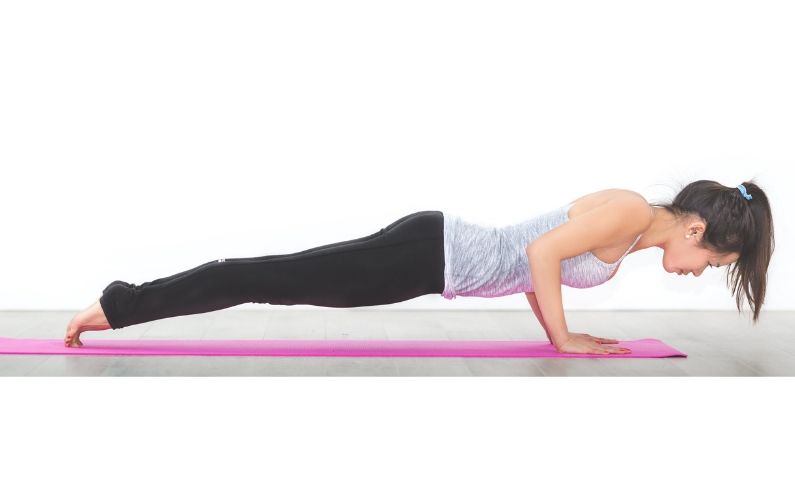
-
The Side Plank
Use a side plank to strengthen your oblique muscles and lower back. Start in a forward plank hold position (elevated on your toes and elbows). Slowly rotate over to one side, putting the weight on your left arm and feet. Place your right arm at your side or on your hip. As you move into this side plank position, your hips will want to sink down to the ground; this can cause strain in the lower back. Instead, be sure to hold your abdominal muscles tight and keep your hips raised. Hold the position for as long as you can – up to two minutes, and then repeat on the right side.
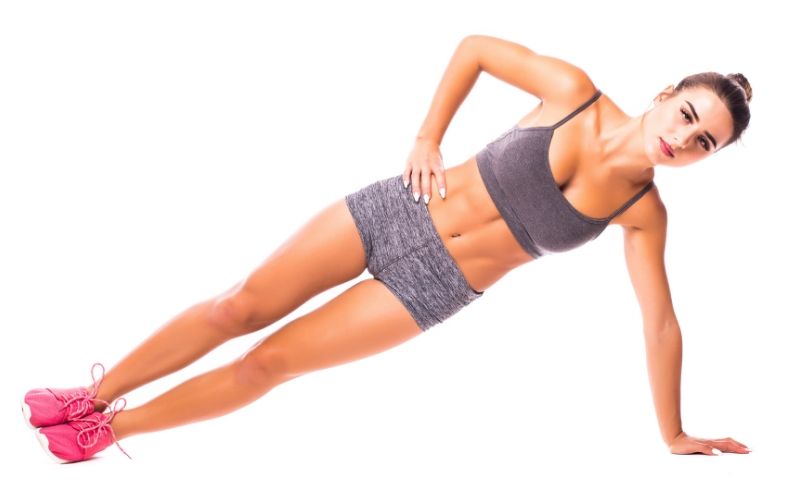
-
Bird Dogs or Superman’s (kneeling extensions)
Great for strengthening the cross links of the body. We naturally move bi-pedally, but often we have a side that is more strong or more balanced than the other. This helps bring back that balance and improve the diagonal muscle links within your core. Start this move by kneeling on all fours with your hands beneath your shoulders and your knees directly below your hips. Tighten your core muscles and slowly lift your right arm and extend it straight forward. Slowly lift your left leg and extend it straight back, with your toes pointed down. Hold for 10 seconds and slowly lower to starting position. Repeat three times on each side. If this movement is too advanced, try the easy modifications of this movement, lifting just an arm or just a leg. Hold for 10 seconds and slowly return to starting position. Repeat three times on each side.
-
Hip Lifts
Lie on your back with your knees bent and with your arms flat on the floor on either side of you. Your fingertips should barely be able to touch your heels. Engage your core. Rotating your pelvis and tailbone down, tighten your core muscles and push your lower back into the floor. Holding this position, slowly lift your midsection off the ground, using your legs, arms and shoulders to balance. Hold in an elevated position for 10 seconds, and slowly lower to starting position, relaxing the core muscles. Repeat five times.
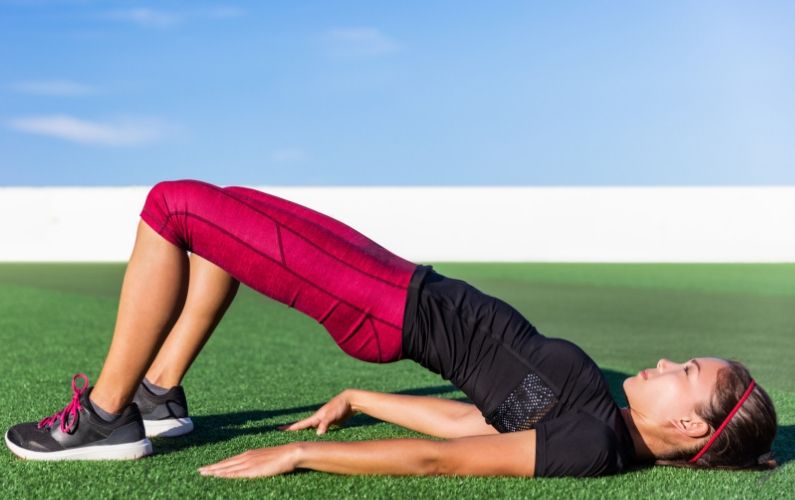
-
Abdominal Crunch
Having a strong core can help you reduce lower back pain. Try this crunch to increase abdominal strength. Lying on your back with your lower legs resting comfortably on a yoga ball or chair, place your fingers gently behind you head and lift your chin to the ceiling. Tighten your abdominal muscles and use these muscles to slowly elevate your shoulders off of the floor – this will cause your stomach to crunch together and you core muscles to contract. Slowly lower back to starting position. Repeat a series of 10, three times, adding more as your core gets stronger.
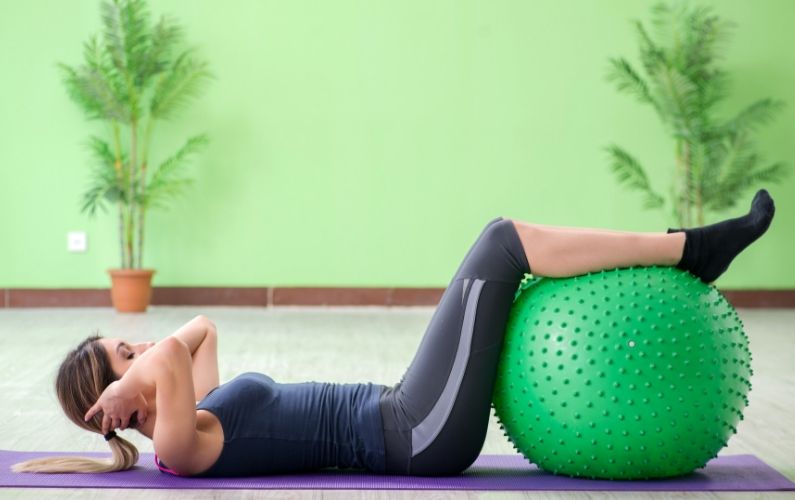
Conclusion
Becoming a better rider requires spirit, mind and body. Let me know if you’ve found this post helpful. I’d also be interested in knowing if you have found some awesome exercises to do under saddle! We all want to spend more time on our horse!
If you are on the hunt for your first horse or you next dream horse, then you will want to get my free Dream Horse Buyer’s Guide! If contains everything you need to know to narrow your search and select your new best friend! Get it today by clicking the button below!
Enjoy the Ride!

